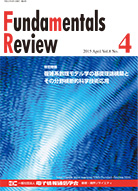Volume 8, Issue 4
Displaying 1-18 of 18 articles from this issue
- |<
- <
- 1
- >
- >|
Cover
-
2015Volume 8Issue 4 Pages 4_0
Published: April 01, 2015
Released on J-STAGE: April 01, 2015
Download PDF (249K)
Table of Contents
-
2015Volume 8Issue 4 Pages 213
Published: March 30, 2015
Released on J-STAGE: April 01, 2015
Download PDF (133K)
Preface
-
2015Volume 8Issue 4 Pages 214-215
Published: April 01, 2015
Released on J-STAGE: April 01, 2015
Download PDF (551K)
Mourning Article
-
2015Volume 8Issue 4 Pages 216
Published: April 01, 2015
Released on J-STAGE: April 01, 2015
Download PDF (199K) -
2015Volume 8Issue 4 Pages 217
Published: April 01, 2015
Released on J-STAGE: April 01, 2015
Download PDF (270K)
Special Contribution
-
2015Volume 8Issue 4 Pages 218-228
Published: April 01, 2015
Released on J-STAGE: April 01, 2015
Download PDF (6944K)
Origins of Technology
-
2015Volume 8Issue 4 Pages 229-243
Published: April 01, 2015
Released on J-STAGE: April 01, 2015
Download PDF (5544K)
Review Papers
Proposed by IMQ
-
2015Volume 8Issue 4 Pages 244-264
Published: April 01, 2015
Released on J-STAGE: April 01, 2015
Download PDF (2553K)
Proposed by R
-
2015Volume 8Issue 4 Pages 265-275
Published: April 01, 2005
Released on J-STAGE: April 01, 2015
Download PDF (1376K)
Proposed by TL
-
2015Volume 8Issue 4 Pages 276-291
Published: April 01, 2005
Released on J-STAGE: April 01, 2015
Download PDF (848K)
Proposed by EA
-
2015Volume 8Issue 4 Pages 292-313
Published: April 01, 2015
Released on J-STAGE: April 01, 2015
Download PDF (2032K)
Proposed by MSS
-
2015Volume 8Issue 4 Pages 314-321
Published: April 01, 2015
Released on J-STAGE: April 01, 2015
Download PDF (2159K)
Miscellaneous Articles
ESS News
-
2015Volume 8Issue 4 Pages 322
Published: April 01, 2015
Released on J-STAGE: April 01, 2015
Download PDF (128K)
International Conference Report
-
2015Volume 8Issue 4 Pages 323-324
Published: April 01, 2015
Released on J-STAGE: April 01, 2015
Download PDF (527K)
Column
-
2015Volume 8Issue 4 Pages 325-326
Published: April 01, 2015
Released on J-STAGE: April 01, 2015
Download PDF (324K)
Winners' Voice
-
2015Volume 8Issue 4 Pages 327-329
Published: April 01, 2015
Released on J-STAGE: April 01, 2015
Download PDF (1098K)
Call for Papers
-
2015Volume 8Issue 4 Pages 330-331
Published: April 01, 2015
Released on J-STAGE: April 01, 2015
Download PDF (290K)
Committees & Editors Notes
-
2015Volume 8Issue 4 Pages 332-334
Published: April 01, 2015
Released on J-STAGE: April 01, 2015
Download PDF (373K)
- |<
- <
- 1
- >
- >|
